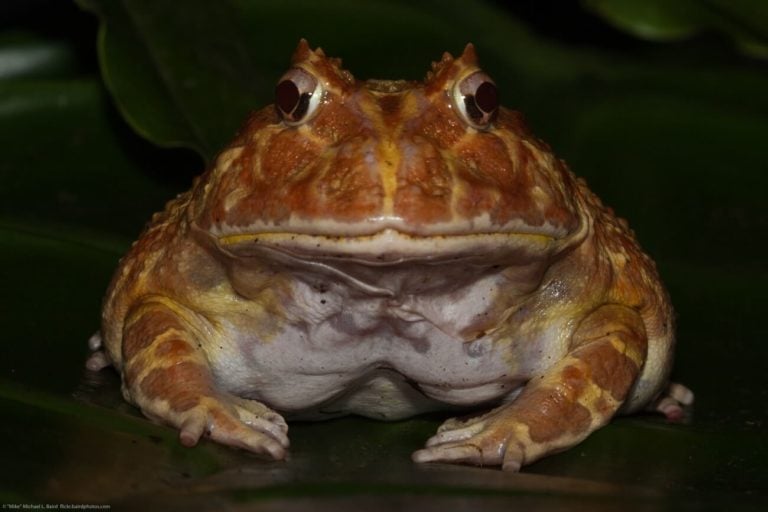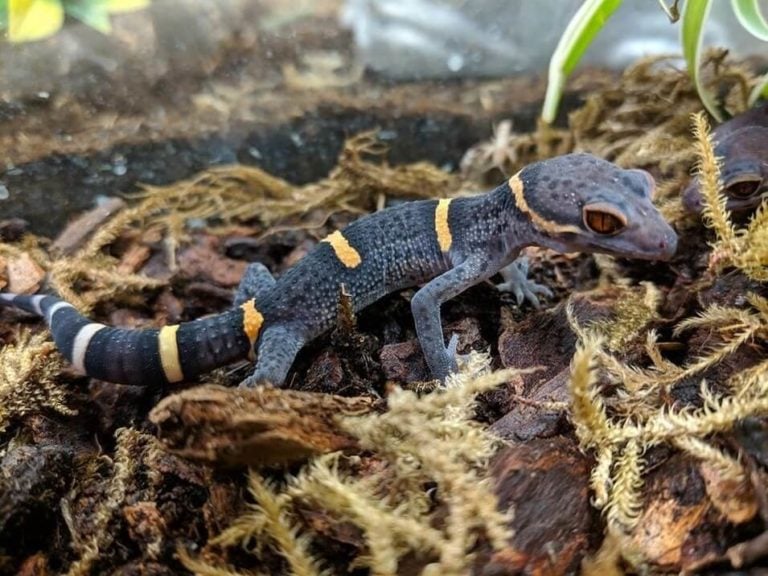Leachianus Geckos are a fascinating reptile that we recommend to anyone. With their unique appearance and ease of care, they make a great choice for someone looking for a large (but low maintenance) pet.
Because of their size and the variety of names people use when referring to them, there is a bit of confusion out there about some of their fundamental care requirements.
And that’s what this guide will clear up. It will teach you the essentials of Leachianus Gecko care, plus helpful facts about this species you’ll want to know!
Table of Contents
Species Summary
The Leachianus Gecko (Rhacodactylus leachianus) is a unique reptile with a distinct claim to fame! It’s the largest living member of the gecko family.
For some reason, these reptiles are referred to by a mix of names. This can make things a bit confusing at first.
Leachianus Gecko, New Caledonian Giant Gecko, and Rhacodactylus leachianus are all used interchangeably. Most animals have a clear “main name” that people use, but these creatures are a bit different (we’re honestly not sure why).
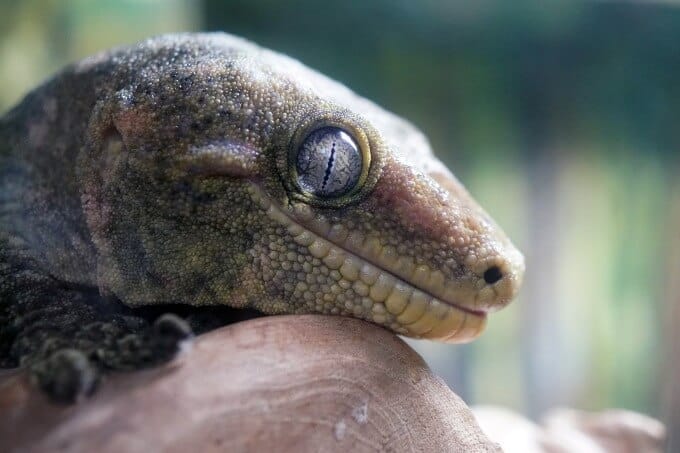
This lizard has all the hallmarks you’d expect from a smaller gecko. However, it’s massive size makes it a highly sought-after species among reptile enthusiasts.
Leachianus Geckos are readily available in the reptile trade. However, they are far rarer than other species. Due to their small clutch size and infrequent breeding, these geckos typically cost more, too.
Originally, the geckos are found in New Caledonia. These days, the export of wild lizards is no longer permitted.
Despite their large size, New Caledonian Giant Geckos aren’t too difficult to care for. They are relatively easy-going and have fewer care requirements to worry about compared to other reptile species.
Lifespan
In captivity, the average Leachianus Gecko lifespan is usually between 15 and 20 years. Choosing to keep one of these cool lizards as a pet means you’ll have them for quite a while!
Like any other pet, the lifespan of the Leachianus Gecko is directly affected by the care you provide. Every detail from their environment to their diet could affect the lizard’s overall life expectancy.
Appearance & Colors
At first glance, you might have a hard time seeing a Leachianus Gecko in a well-designed habitat.
These lizards are built for camouflage. Their bodies are covered in natural color morphs that help them blend in with the natural backdrop of New Caledonia.
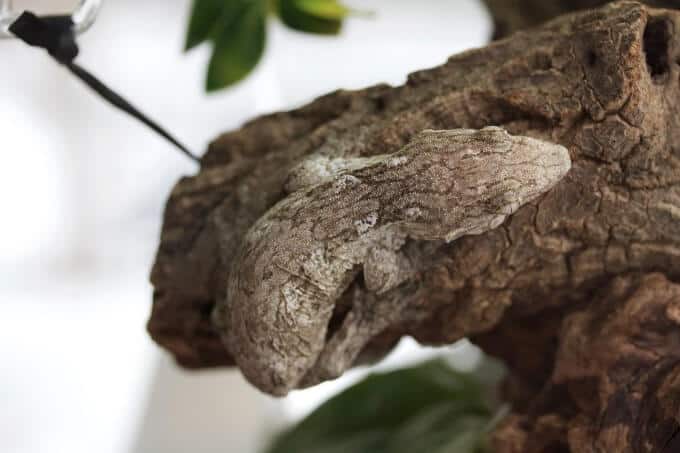
There’s a lot of color variation out there. You can find lizards with a host of colors all over their body.
In most cases, the lizards have patches of gray, brown, black, and green. You might also see some vivid white spots or darker brown stripes. Even bright hues of orange and salmon are common.
All of those colors blend to create a stealthy morph.
As for shape, the New Caledonian Giant Gecko has a familiar profile. It looks like any other gecko species you may be familiar with.
However, there are some noticeable distinctions.
The first is the large triangular head. Sitting on top of the head are two large gray eyes. The rest of the body is pretty thick, too. This gives the lizard a somewhat intimidating appearance compared to other species.
The tail of the Leachianus Gecko is a bit unique as well. It has a thicker base and a short thin section. These two sections of the tail are separated by a fold of skin, making it look like it’s regenerated.
Expert Tip: Rhacodactylus leachianus can lose and regenerate their tails. However, it doesn’t happen as often as it does with other species.
It’s pretty rare for the tail to fall off when you’re handling the lizard. In most cases, it’s lost in a territorial squabble with another lizard!
Average Size
The average size of Leachianus Geckos can be up to 17 inches in max length! Healthy adults are usually somewhere between 14 and 17 inches.
Juveniles are pretty big right off the bat. When they first hatch, the baby geckos are already about 4 inches long!
Unlike some other reptile species, there aren’t any major size differences between male and female lizards.
Leachianus Gecko Care
Leachianus Gecko care requires you to initially spend a bit of time getting everything ready. Like all reptiles, this species has some distinct care requirements that you need to follow.
These creatures aren’t like canines or fish. You have to maintain the right temperatures, humidity levels, and more.
Luckily, Rhacodactylus leachianus aren’t as demanding as some other species. As long as you provide all of the essentials, these lizards can stay healthy for many years to come.
Enclosure Size
First things first, there’s the enclosure. It’s important to take some time choosing am enclosure that has enough room for your Leachianus Gecko. These are larger reptiles that need plenty of space to explore!
It’s recommended that you keep adult Leachianus Geckos in a tank that can hold at least 40 gallons.
But don’t forget to pay attention to the dimensions of the enclosure, instead of focusing solely on its volume.
These geckos are largely arboreal. Thus, they need a lot of vertical climbing space.
A tank that measures 18 inches wide, 18 inches long, and 24 inches high should suffice.
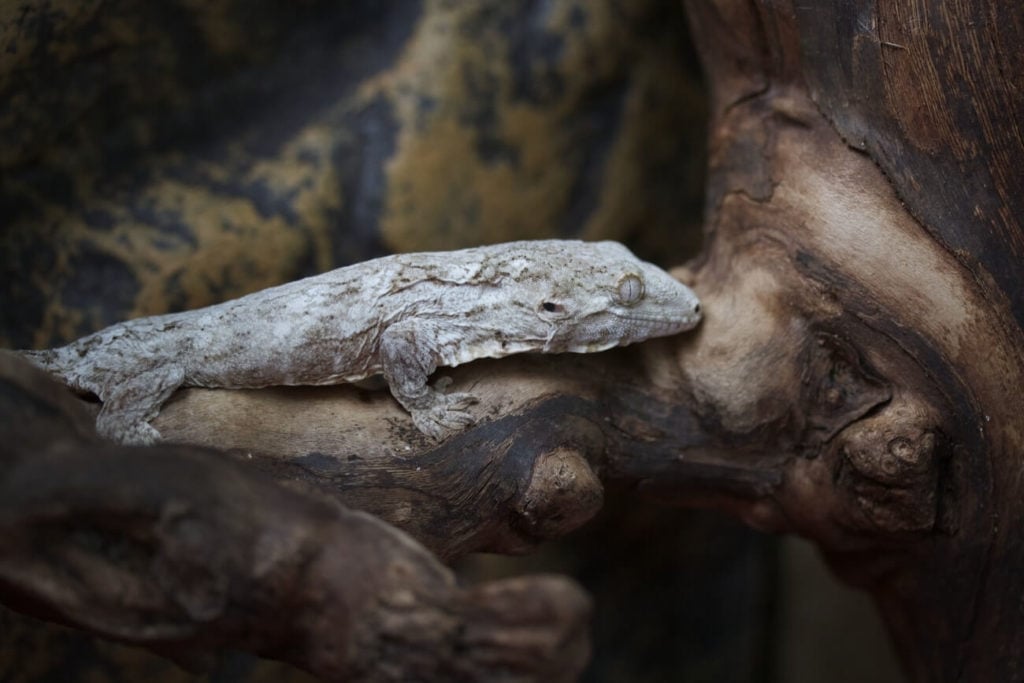
If you can get a tank that’s a bit bigger, go for it! New Caledonian Giant Geckos do very well when kept in pairs. Having a slightly bigger tank for two geckos to cohabitate can be beneficial.
As for the build of the tank, go with an option that has at least one screened side. Many owners prefer to utilize enclosures that have a screened front and top. This provides adequate ventilation to help you avoid respiratory issues.
Expert Tip: Juvenile Leachianus Geckos should not be kept in a large tank. A smaller 10-gallon tank is best for baby geckos. Placing juveniles in a massive enclosure can cause stress.
Habitat & Enclosure Setup
Providing a realistic environment filled with plenty of enriching decorations is essential. Leachianus Geckos will spend time in various parts of the enclosure, so it’s good to fill the habitat up with decorations that match their natural habitat.
Starting with the bottom of the enclosure, fill it with a soft substrate. You can use untreated high-grade mulch. Peat moss or potting soil works well, too.
Soil is a good option if you plan on incorporating live plants into the enclosure. However, make sure that the bottom has proper drainage if you go this route.
Live plants aren’t necessary. In fact, artificial ones work just as well!
Go with fake plants that have plastic leaves. Leachianus Geckos will often sip off water droplets that form on leaves. If you’re planning on doing live plants, options like ferns, Devil’s ivy, and Heart Leaf Philodendron work well.
A nice hiding spot is also recommended for the bottom of the enclosure. You can use a nesting box or create a house out of cork bark.
Once the bottom of the enclosure is done, you’ll need to create a nice network of climbing surfaces!
The goal is to create multiple routes to various parts of the enclosure. You can do this with climbing branches and sturdy vines. Make sure that a good portion of these branches are covered in absorbent bark to help with humidity levels.
Temperature & Lighting
Leachianus Geckos prefer temperatures around 75 degrees Fahrenheit throughout the day.
You can also create hot spots of up to 82 degrees Fahrenheit at one part of the tank. This is easily done with a heat emitter or lamp.
Use your discretion when it comes to overall temperature management. If temperatures dip below the low 70s at night, you may want to install a heat emitter.
Interestingly enough, standalone lighting isn’t a necessity for Rhacodactylus leachianus. They can do fine with whatever normal lighting the room gets. Just make sure you turn any lights off at night since these creatures are nocturnal.
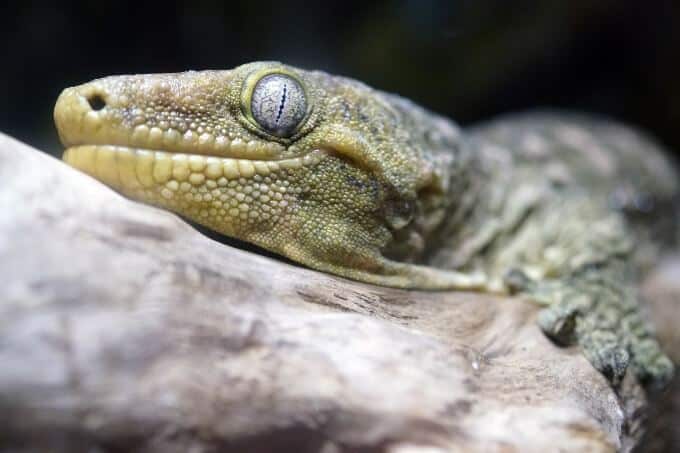
In fact, they don’t even need UVB lights to metabolize calcium, which is a nice perk.
If kept in a low-light part of your home, you may want to install lights to simulate the day/night cycle as well. However, if you plan accordingly, you can get by without lights at all!
Water & Humidity
While these reptiles will sip on water droplets, they do require a water dish. Place a sturdy dish at the bottom of the enclosure and make sure it’s filled with fresh water at all times.
Expert Tip: Choose a dish that’s solid enough to stay upright. These are large reptiles that can easily flip smaller dishes.
Leachianus Geckos do require moderate humidity levels as well. Ideally, the tank should be between 50 and 75 percent humidity at all times. Use a hygrometer to measure humidity levels regularly.
To maintain those levels, mist the tank two or three times a week. Alternatively, you can invest in an automatic mister to maintain levels constantly.
Food & Diet
Leachianus Geckos will accept a wide variety of foods. In the wild, they typically consume fruits and live insects.
To make things easier, you can use commercial gecko food as their main diet staple. However, supplementary snacks are still recommended.
Feed your lizard insects once or twice a week. Waxworms, Dubia roaches, and crickets are all good choices.
Make sure to coat the insect in powdered calcium supplements. The insects should also be gut loaded with calcium-rich foods to ensure that your reptile is getting all the minerals they need.
Expert Tip: In addition to insects, you can provide fruit puree. There are plenty of great powder mixes available to create an enriched puree your geckos will love.
Potential Health Issues
Like other reptiles, Leachianus Geckos are susceptible to a couple of health issues. Mouth rot is the most common. When this occurs, your lizard’s mouth and eyes may become inflamed.
Respiratory infections and skin infections are pretty common, too.
All of these issues are usually caused by poor living conditions. Too much exposure to moisture, in particular, has been known to cause some nasty skin issues.
Luckily, all of those conditions are easily treated by a vet. Even better, you can avoid them altogether by staying on top of tank maintenance.
Clean up spills quickly and disinfect the environment regularly to keep your geckos healthy!
Behavior & Temperament
Leachianus Geckos are relatively docile. However, they can get territorial in certain situations.
We mentioned earlier that these reptiles do well in pairs. However, this is only true if it’s a male and female breeding pair.
Otherwise, you may encounter aggression. Lizards that are unfamiliar with one another have been known to fight. So, exercise caution and only keep a pair together if they are properly bonded.
Handling Them
Occasional aggression may extend to you as well. Leachianus Geckos aren’t big fans of being handled. Of course, this varies based on the lizard.
Some will get used to handling while others get stressed out when you try to lift them (even after you’ve owned them for years).
If you need to move the lizard, approach carefully. Grasp them gently behind the neck area and support their legs.
Make sure that you don’t startle the lizard. They may try to bite you.
Once they are in your hand, don’t grip onto them too tightly. They might try to escape, so be prepared to extend your other hand to catch them.
Over time, your gecko may get more comfortable with handling. However, you should never push this. Keep handling to a minimum, pay attention to the signs they give you, and always approach the lizard gently to avoid stress.
Ready To Get One Of These Giants For Yourself?
Now that you know what proper Leachianus Gecko care looks like, you’ll need to decide if this species is right for you.
We’ve been a big fan of Rhacodactylus leachianus for years, and find ourselves recommending them to other herp-lovers all the time. It’s such a neat feeling to see such a large creature hanging out in your home!
If there are any questions this care guide didn’t cover, you’re more than welcome to ask us directly (just use the contact page on our site). We’re always available to help our readers!

